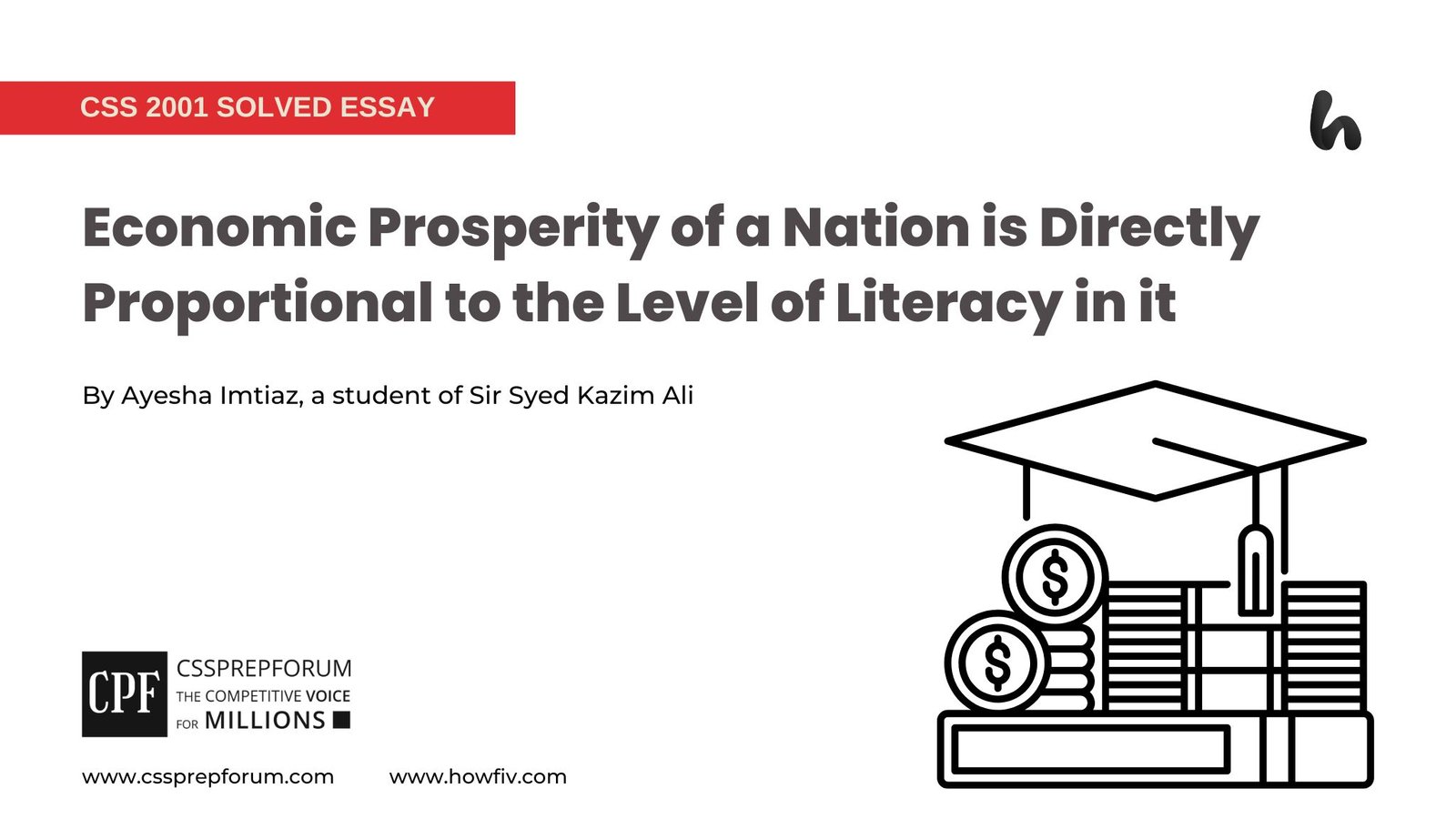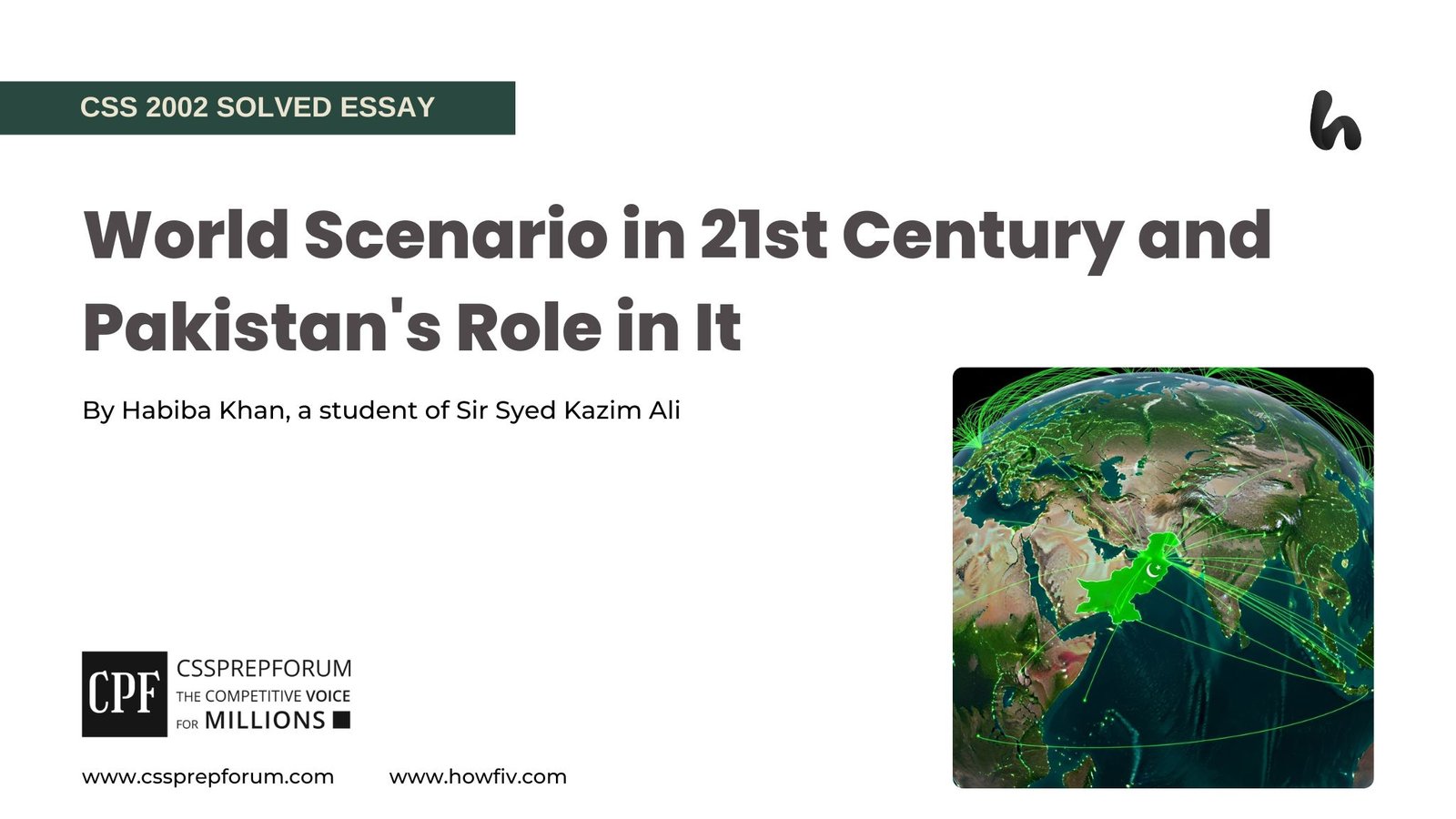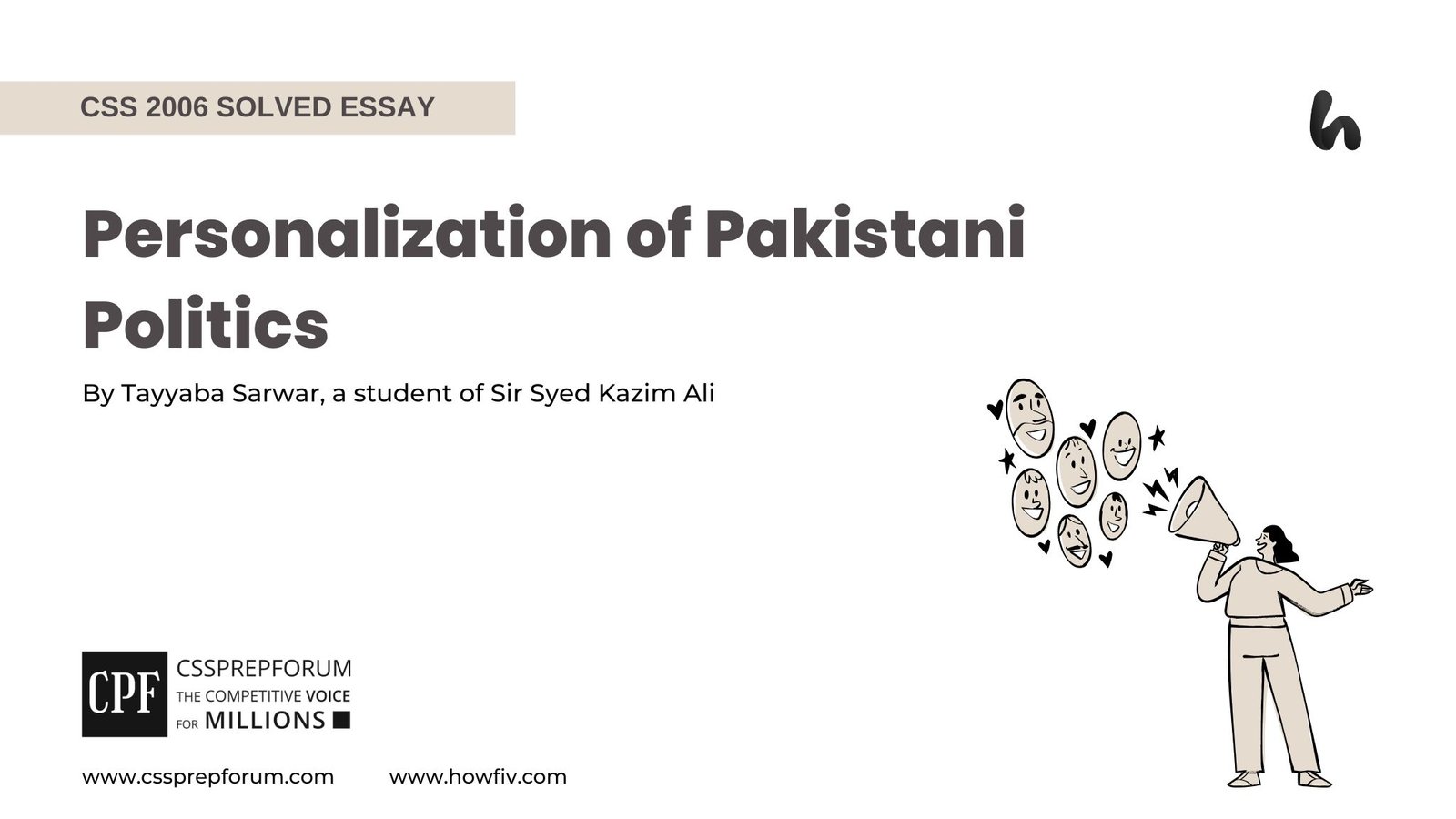CSS 2015 Solved Current Affairs Past Papers | 2014 Floods- Mismanagement of Water Resources
The following question of CSS Current Affairs 2015 is solved by Sir Ammar Hashmi, the best Current Affairs Coach, on the guided pattern of Sir Syed Kazim Ali, which he taught to his students, scoring the highest marks in compulsory subjects for years. This solved past paper question is uploaded to help aspirants understand how to crack a topic or question, how to write relevantly, what coherence is, and how to include and connect ideas, opinions, and suggestions to score the maximum.

Question breakdown
The question asks you to evaluate whether the primary causes of the 2014 floods were Indian water policies or poor management of water resources in Pakistan. It requires an analysis of the main factors and their contributions to the flooding. Essentially, we need to discuss and weigh the impact of external and internal influences on the flood situation.
Outline
1-Introduction
2-An overview of the disastrous floods of 2014
3-Examining Pakistan’s Water Management Shortcomings
- ✓ Lack of hydro infrastructure and poor flood management
- ✓ Encroachment and Unplanned Urbanization
- ✓ Global climate change and Neglect of River Maintenance in Pakistan
- ✓ Failure of Water Governance and Policy Implementation
4-Anti-Thesis: Assessing the Role of Indian Water Management in the 2014 Pakistan Floods
- ✓ Strategic Manipulation of Water Flow from Indian Dams
- ✓ Violation of the Indus Waters Treaty
5-Recommendations for Preventing Future Floods
- ✓ Strengthening Water Management Infrastructure, Flood Prediction and Early Warning Systems
- ✓ Integrated Water Resources Management (IWRM)
- ✓ Bilateral Water Diplomacy
6-Critical Analysis
7-Conclusion

Answer to the question
Introduction
Pakistan’s recurring floods are tied to its neglect of river maintenance and poor infrastructure. The disaster of 2014 was attributed to not only natural causes but Indian water terrorism as well, alleging that India released excessive water from its dams without prior information. Another significant factor is the mismanagement of water resources in Pakistan. This includes poor maintenance of embankments, deforestation, unplanned urban development, and lack of proper drainage systems, increasing the vulnerability of flood-affected regions. It’s on Pakistan to prepare for water inflows, especially during heavy rainfalls caused by monsoons. India’s actions were not necessarily illegal to frame them as deliberate aggression that detracts Pakistan from the fundamental problem, i.e., chronic mismanagement of its water resources and infrastructure. Water diplomacy could lead to better cooperation between the two countries in the case of shared rivers. Additionally, both India and Pakistan need collaborative climate change management and disaster preparedness.
The disastrous floods of 2014
The floods of 2014 were the most devastating in the country’s history. It was triggered by severe monsoon rains in September, leading to the overflow and swelling of major rivers, mainly Jhelum and Chenab. These rivers cover vast areas of Punjab, parts of Gilgit Baltistan, and Azad Jammu and Kashmir. It cost the lives of over 200 people, the displacement of millions, and the devastation of approximately two million acres of crops. The economic loss was estimated to be approximately $400 million, which encompassed the agricultural sector majorly, the backbone of the country’s economy. This disaster was attributed to natural causes like heavy monsoon rains and Indian water terrorism, as well as alleging India released excess water from its dams without prior information. However, a major factor was internal mismanagement of water resources, which included poor maintenance of embankments, deforestation, unplanned urban development, and lack of proper drainage systems, which increased the vulnerability of flood-affected regions. It was reported that about 2.5 million people were affected, 1.1 million acres of crops were destroyed, 2,500 villages were inundated, and 1.5 million homes were damaged. Pakistan’s recurring floods are tied to its dependence on rivers and its poor infrastructure. Significant reforms for water management are required to save the country from similar disasters in the future which put its population at continued risk.
Examining Pakistan’s Water Management Shortcomings
- ✓ Lack of Infrastructure and poor flood management:
Pakistan has an insufficient and poorly maintained flood management infrastructure, which exacerbates the impact of heavy rains and river overflow. The country’s embankments and flood protection dikes along the Chenab, Jhelum, and Indus River structures are in a dilapidated state due to insufficient maintenance and lack of modernization. During the 2014 floods, apart from widespread inundation in areas such as Azad Jammu and Kashmir and Punjab, in the district of Jhang, the riverbanks failed to contain the surging waters, which resulted in severe damage to homes, infrastructure, and farmlands. But the challenges don’t stop here; Pakistan faces issues with its irrigation infrastructure, such as outdated canals and water distribution systems, inefficient irrigation practices, and water logging and salinity problems resulting in substantial water wastage, which could otherwise be used to mitigate the effects of flooding or support agricultural needs.
- ✓ Encroachment and Unplanned Urbanization:
Encroachment is the illegal occupation of land near waterways and rivers, and it plays a key role in worsening floods. In cities like Sialkot, Lahore, and Gujranwala, informal buildings and settlements along riverbanks have reduced the natural flow of water. This often led to the blockage of drainage paths, which forced excess water to flood into populated areas. Unplanned urbanization, for example, the rapid expansion of big cities like Lahore without adequate sewage, drainage systems, or flood control measures, has also contributed to the disastrous situation. Concrete structures and roads replaced green spaces resulting in massive pooling in low-lying areas. Encroachment along rivers and increased unregulated urban growth have weakened the country’s ability to manage floods, which showed the need for better urban planning and strict enforcement of regulations to prevent such disasters in the future.
- ✓ Global climate change and Neglect of River Maintenance in Pakistan:
Global climate change has led to more unpredictable and acute weather patterns, including heavier monsoon rains in South Asia. Scientists have long warned that high temperatures would increase the frequency of extreme weather; one of the cases is heavier rainfall in regions like Pakistan. The shift in rainfall patterns is linked to climate change, which is leading to more erratic weather across the globe. Another significant factor was the neglect of river maintenance, as riverbeds have not been dredged properly, and accumulated silt and debris that have not been cleared. The failure of rivers to handle the increased water flow, amalgamated with the unpredictable and intense monsoon rains driven by climate change, led to devastating floods in Pakistan. It serves as a stark reminder of the importance of timely climate adaptation and proper infrastructure to mitigate the impacts of future climate-driven events.
- ✓ Failure of Water Governance and Policy Implementation:
The Federal Flood Commission (FFC), provincial irrigation departments, and the Water and Power Development Authority (WAPDA) manage Pakistan’s water resources. However, these managing bodies have little coordination. Thus, the fragmented approach to water governance meant no single authority would oversee the entire water system. This led to inefficiencies in flood prediction, preparation, and appropriate response. The Country’s National Water Policy was drafted decades ago and is still used. Still, it lacks in addressing contemporary dynamics like increased flood risks due to encroachment, global warming, and unplanned urbanization. Moreover, the lack of proper implementation of flood management policies has also aggravated the situation. In 2014, all types of infrastructure, like homes, bridges, and roads, were severely damaged, and many communities were cut off from emergency aid due to poor planning and coordination. The 2014 flash floods are a tragic example of how poor governance and ineffective implementation can significantly worsen the impact of natural disasters.
Antithesis-Assessing the Role of Indian Water Management in the 2014 Pakistan Floods
- ✓ Water Release from Indian Dams:
India and Pakistan share a delicate relationship regarding sharing water resources currently governed by the Indus Water Treaty of 1960. Some Pakistani officials and statisticians reported that one of the key causes of flooding was the release of water without proper prior notification to Pakistan, which eventually exacerbated the flooding in Punjab, Azad Jammu and Kashmir areas. It was alleged that India released thousands of cubic meters of water from the Baglihar Dam into the Chenab River, which flows into Pakistan. This extraordinary water flow coincided with heavy rains, overwhelmed the riverbanks, and eventually led to the disaster. The areas downstream of the Chenab include Multan, Jhang, Gujranwala, and a few others suffered the worst impacts.
- ✓ Violation of the Indus Waters Treaty:
The Indus Water Treaty, signed in 1960, is an agreement brokered by the World Bank between India and Pakistan. It regulates the usage of the waters of the Indus River system by both countries, e.g. Pakistan is given control over the western rivers (Indus, Chenab, and Jhelum), and India has rights over the eastern rivers (Sutlej, Beas, and Ravi). India violated the spirit of the treaty by constructing hydroelectric projects and dams on the western rivers, which gave it the ability to control water flows into Pakistan, for example, the Baglihar Dam on the Chenab River. In September 2014, the sudden release of water from Baglihar was cited as one of the triggers for the rapid rise in water levels. After crossing the Indian border, the Chenab River swelled to over 700,000 cusecs (cubic feet per second), which far exceeded the river’s capacity and severely damaged the areas in its vicinity.
- ✓ Strategic Manipulation of Water Flow:
The exact figures of Indian dam water release to the scale of the floods remain challenging to confirm. Still, the timing of water release during critical periods of monsoon season raised suspicions in Pakistan against India. These are not just allegations as Pakistan has long been in fear that India, through its upstream control of rivers, could either cause flood in downstream areas by releasing it or drought-like conditions by holding back water; such actions are proof of a non-military form of aggression, to destabilize Pakistan’s agricultural and disrupt its infrastructure. Strategically, Pakistan is highly dependent on the Indus River for its water use, economy, energy production, and food security. More than 90% of Pakistan’s water comes from the Indus Basin, which employs about 40% of the workforce and contributes significantly to its GDP. So, manipulating the flow of these rivers could have catastrophic effects on for country’s economy and food supply.
Recommendations for Preventing Future Floods
- ✓ Strengthening Water Management Infrastructure, Flood Prediction and Early Warning Systems:
Pakistan’s water infrastructure needs upgrading existing dams or constructing new ones, which will help regulate river flows and store excess water for use during drought, reducing the risk of floods. For instance, the capacity of Mangla and Tarbela Dam on the Indus River can be enhanced to prevent downstream flooding during excessive rainfall. Additionally, strengthening embankments along rivers like the Indus, Jhelum, and Chenab is crucial to containing floodwaters and protecting surrounding communities. Moreover, better drainage systems would reduce urban flooding caused by heavy rains as rapid urbanization has destroyed drainage channels and paved over green spaces that usually absorb rainwater. Singapore is a good example, as it has incorporated integrated water management into its urban planning, reducing flood risks even with high rainfall. Apart from this, flood prediction and early warning systems can also help to reduce damage and save lives; real-time monitoring of rivers, rainfall, and weather patterns can help authorities take timely preventive measures and issue early warnings. Bangladesh has developed a sophisticated flood warning system based on satellite data and significantly reduced the death toll from floods over decades, setting an example for Pakistan to develop a more comprehensive flood prediction system.
- ✓ Integrated Water Resources Management (IWRM):
Integrated Water Resource Management (IWRM) could help Pakistan in the prevention of future floods by ensuring that various stakeholders like federal, provincial, and local authorities and private sectors work together in managing water resources from upstream to downstream regions. This approach could ensure better coordination and management across regions, improving flood resilience. The important aspect of IWRM is the coordinated management of upstream and downstream areas as interconnected systems, for example, upstream water from major reservoirs and dams, must be coordinated to prevent downstream flooding. Additionally, it promotes the balanced use of water resources, which maintains the health of ecosystems such as wetlands and floodplains. To improve flood control, IWRM could also promote coordinated investments in dams, levees, drainage systems, and barrages. The Mekong River Basin in Southeast Asia is one successful example of IWRM, where coordinated efforts between countries like Vietnam, Laos, and Thailand have led to better water management and reduced flood impacts through collaborative governance.
- ✓ Bilateral Water Diplomacy:
Joint mechanisms for hydrological data and improvement in communication between water management agencies in India and Pakistan would be a key outcome of enhanced water diplomacy. It could also foster joint investments in projects aimed at improving flood risks. A successful example of bilateral water diplomacy is the cooperation between India and Bangladesh on the Ganges River. Despite tensions, they have developed water sharing and management protocols, linking them with joint commissions to handle transboundary water issues. India and Pakistan could take lessons from this model to improve their own collaboration on the Indus River system. The coordinated efforts between the two countries could help mitigate the impact of future floods, which caused billions of dollars in damages and affected millions of lives. Apart from this, including China in water diplomacy is essential, as rivers like the Sutlej and Indus originate from the Tibetan Plateau. As China controls parts of the upper Indus Basin, trilateral diplomacy between India, China, and Pakistan could lead to more comprehensive water management strategies for flood forecasting, storage infrastructure, and coordinated water releases.
Critical Analysis
It is important for Pakistan to do away with the incumbent reactionary politics and adopt a proactive approach (like empowering DDMAs at the district level) that focuses on strengthening its capacities to mitigate flood risks. The state should actively invest in modernizing the ageing water infrastructure, improving the maintenance of embankments and floodplains, building new reservoirs, and climate-resilient infrastructure to withstand the drastic impacts of the unpredictable monsoons exacerbated mainly by climate change. Pakistan, by shifting its narrative from a blame game to real action, can emerge stronger to face future floods that will break the cycle of disaster and mismanagement that has plagued its water resources for decades. The utmost solution lies in taking ownership of mistakes and failure of policies and building sustainable, long-term strategies and home-grown policies for water governance and flood prevention.
Conclusion
The floods in Pakistan cannot be attributed to a single cause, either its “Indian water terrorism” or Pakistan’s internal mismanagement. There are arguments that India’s dam releases during monsoon have worsened the flood situation in Pakistan, but this “water terrorism” risk cannot overlook the more chronic issues within Pakistan’s water management system. The Indus Waters Treaty provides only a legal framework unable to govern flood management or the timing of water releases. Therefore, the onus also lies in Pakistan to prepare for water inflows, especially during heavy rainfall from monsoons. India’s actions were not necessarily illegal to frame them as deliberate aggression that detracts Pakistan from the fundamental problem, i.e., chronic mismanagement of its water resources and infrastructure. Water diplomacy could lead to better cooperation between the two countries in the case of shared rivers. Additionally, both India and Pakistan need collaborative climate change management and disaster preparedness.

CSS Solved Past Papers’ Essays
Looking for the last ten years of CSS and PMS Solved Essays and want to know how Sir Kazim’s students write and score the highest marks in the essays’ papers? Then, click on the CSS Solved Essays to start reading them.
CSS Solved Essays
CSS Solved General Science & Ability Past Papers
Want to read the last ten years’ General Science & Ability Solved Past Papers to learn how to attempt them and to score high? Let’s click on the link below to read them all freely. All past papers have been solved by Pakistan’s top CSS GSA coach having the highest score of their students.
General Science & Ability Solved Past Papers












